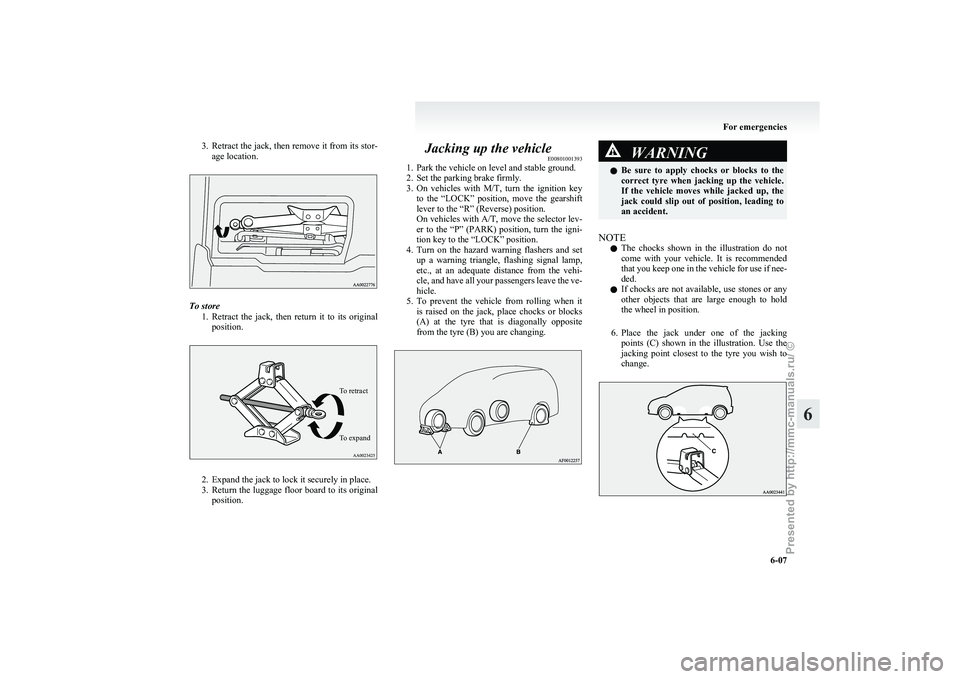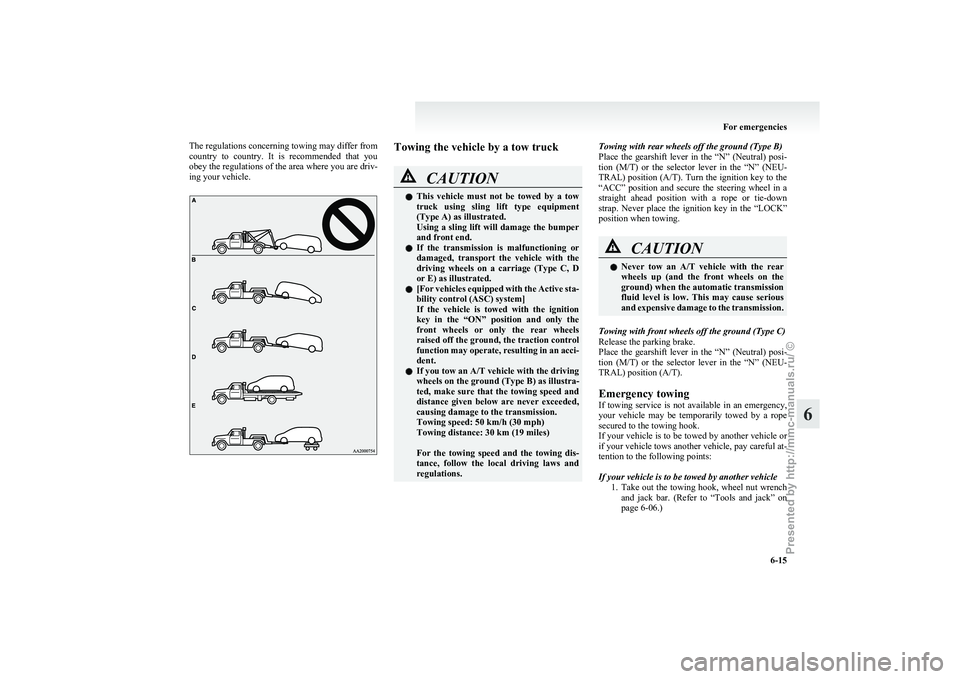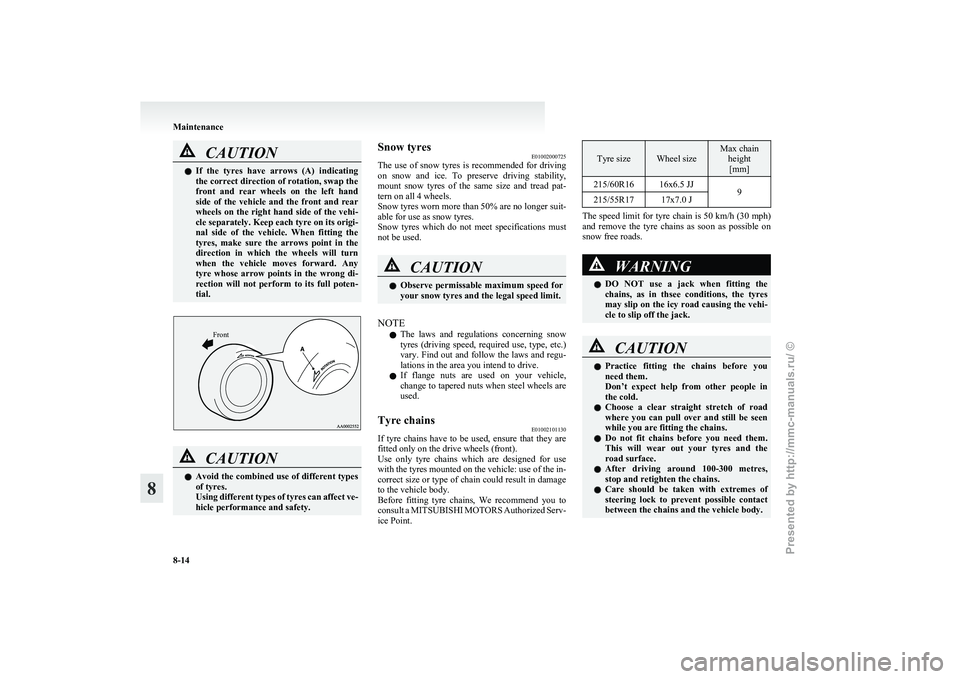jack points MITSUBISHI GRANDIS 2010 Owner's Manual (in English)
[x] Cancel search | Manufacturer: MITSUBISHI, Model Year: 2010, Model line: GRANDIS, Model: MITSUBISHI GRANDIS 2010Pages: 273, PDF Size: 21.01 MB
Page 192 of 273

3. Retract the jack, then remove it from its stor-
age location. To store
1. Retract
the jack, then return it to its original
position.
To retract
To expand 2. Expand the jack to lock it securely in place.
3. Return
the luggage floor board to its original
position. Jacking up the vehicle
E00801001393
1.
Park the vehicle on level and stable ground.
2. Set the parking brake firmly.
3. On vehicles with M/T, turn the ignition key to the “LOCK” position, move the gearshift
lever to the “R” (Reverse) position.
On vehicles with A/T, move the selector lev-
er to the “P” (PARK) position, turn the igni-
tion key to the “LOCK” position.
4. Turn on the hazard warning flashers and set up a warning triangle, flashing signal lamp,
etc., at an adequate distance from the vehi-
cle, and have all your passengers leave the ve-
hicle.
5. To prevent the vehicle from rolling when it is raised on the jack, place chocks or blocks
(A) at the tyre that is diagonally opposite
from the tyre (B) you are changing. WARNING
l Be
sure to apply chocks or blocks to the
correct tyre when jacking up the vehicle.
If the vehicle moves while jacked up, the
jack could slip out of position, leading to
an accident.
NOTE l The
chocks shown in the illustration do not
come with your vehicle. It is recommended
that you keep one in the vehicle for use if nee-
ded.
l If chocks are not available, use stones or any
other objects that are large enough to hold
the wheel in position.
6. Place the jack under one of the jacking points (C) shown in the illustration. Use the
jacking point closest to the tyre you wish to
change. For emergencies
6-07 6
Presented by http://mmc-manuals.ru/ \251
Page 200 of 273

The regulations concerning towing may differ from
country
to country. It is recommended that you
obey the regulations of the area where you are driv-
ing your vehicle. Towing the vehicle by a tow truck
CAUTION
l
This
vehicle must not be towed by a tow
truck using sling lift type equipment
(Type A) as illustrated.
Using a sling lift will damage the bumper
and front end.
l If the transmission is malfunctioning or
damaged, transport the vehicle with the
driving wheels on a carriage (Type C, D
or E) as illustrated.
l [For vehicles equipped with the Active sta-
bility control (ASC) system]
If the vehicle is towed with the ignition
key in the “ON” position and only the
front wheels or only the rear wheels
raised off the ground, the traction control
function may operate, resulting in an acci-
dent.
l If you tow an A/T vehicle with the driving
wheels on the ground (Type B) as illustra-
ted, make sure that the towing speed and
distance given below are never exceeded,
causing damage to the transmission.
Towing speed: 50 km/h (30 mph)
Towing distance: 30 km (19 miles)
For the towing speed and the towing dis-
tance, follow the local driving laws and
regulations. Towing with rear wheels off the ground (Type B)
Place
the gearshift lever in the “N” (Neutral) posi-
tion (M/T) or the selector lever in the “N” (NEU-
TRAL) position (A/T). Turn the ignition key to the
“ACC” position and secure the steering wheel in a
straight ahead position with a rope or tie-down
strap. Never place the ignition key in the “LOCK”
position when towing. CAUTION
l
Never
tow an A/T vehicle with the rear
wheels up (and the front wheels on the
ground) when the automatic transmission
fluid level is low. This may cause serious
and expensive damage to the transmission.
Towing with front wheels off the ground (Type C)
Release the parking brake.
Place
the gearshift lever in the “N” (Neutral) posi-
tion (M/T) or the selector lever in the “N” (NEU-
TRAL) position (A/T).
Emergency towing
If towing service is not available in an emergency,
your vehicle may be temporarily towed by a rope
secured to the towing hook.
If your vehicle is to be towed by another vehicle or
if your vehicle tows another vehicle, pay careful at-
tention to the following points:
If your vehicle is to be towed by another vehicle
1. Take out the towing hook, wheel nut wrenchand jack bar. (Refer to “Tools and jack” on
page 6-06.) For emergencies
6-15 6
Presented by http://mmc-manuals.ru/ \251
Page 223 of 273

CAUTION
l
If the tyres have arrows (A) indicating
the correct direction of rotation, swap the
front and rear wheels on the left hand
side of the vehicle and the front and rear
wheels on the right hand side of the vehi-
cle separately. Keep each tyre on its origi-
nal side of the vehicle. When fitting the
tyres, make sure the arrows point in the
direction in which the wheels will turn
when the vehicle moves forward. Any
tyre whose arrow points in the wrong di-
rection will not perform to its full poten-
tial.
Front CAUTION
l
Avoid
the combined use of different types
of tyres.
Using different types of tyres can affect ve-
hicle performance and safety. Snow tyres
E01002000725
The
use of snow tyres is recommended for driving
on snow and ice. To preserve driving stability,
mount snow tyres of the same size and tread pat-
tern on all 4 wheels.
Snow tyres worn more than 50% are no longer suit-
able for use as snow tyres.
Snow tyres which do not meet specifications must
not be used. CAUTION
l
Observe
permissable maximum speed for
your snow tyres and the legal speed limit.
NOTE l The
laws and regulations concerning snow
tyres (driving speed, required use, type, etc.)
vary. Find out and follow the laws and regu-
lations in the area you intend to drive.
l If flange nuts are used on your vehicle,
change to tapered nuts when steel wheels are
used.
Tyre chains E01002101130
If tyre chains have to be used, ensure that they are
fitted only on the drive wheels (front).
Use
only tyre chains which are designed for use
with the tyres mounted on the vehicle: use of the in-
correct size or type of chain could result in damage
to the vehicle body.
Before fitting tyre chains, We recommend you to
consult a MITSUBISHI MOTORS Authorized Serv-
ice Point. Tyre size Wheel size Max chain
height[mm]
215/60R16 16x6.5 JJ 9
215/55R17 17x7.0 J The speed limit for tyre chain is 50 km/h (30
mph)
and remove the tyre chains as soon as possible on
snow free roads. WARNING
l DO
NOT use a jack when fitting the
chains, as in thsee conditions, the tyres
may slip on the icy road causing the vehi-
cle to slip off the jack. CAUTION
l
Practice
fitting the chains before you
need them.
Don’t expect help from other people in
the cold.
l Choose a clear straight stretch of road
where you can pull over and still be seen
while you are fitting the chains.
l Do not fit chains before you need them.
This will wear out your tyres and the
road surface.
l After driving around 100-300 metres,
stop and retighten the chains.
l Care should be taken with extremes of
steering lock to prevent possible contact
between the chains and the vehicle body. Maintenance
8-14
8
Presented by http://mmc-manuals.ru/ \251